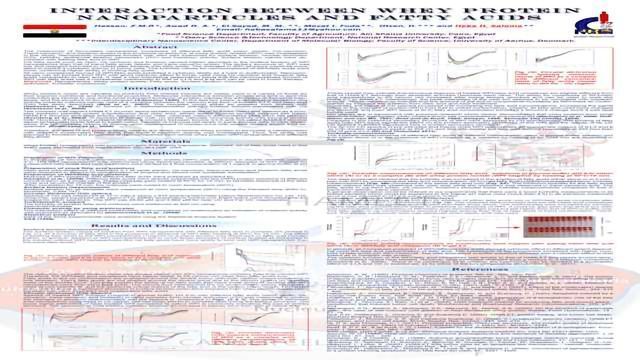Latest Posters

Poster
CAPILLARY ELECTROPHORESIS OF APIGENIN
* Application of an appropriate mode of extraction allowed to use on-line stacking method for the determination of apigenin in plant extracts,
* The low limit of detection was 5 nmol in 1 mL of plant extract,
* Presented procedure allows approximately 20-fold increase of sensitivity,
* Elaborated assay can be useful for the determination of apigenin in biological samples.
* The low limit of detection was 5 nmol in 1 mL of plant extract,
* Presented procedure allows approximately 20-fold increase of sensitivity,
* Elaborated assay can be useful for the determination of apigenin in biological samples.

Poster
INTERACTION BETWEEN WHEY PROTEIN NANOPARTICLES AND FATTY ACIDS
Nanocomplexes can be formed from WPI with good cytotoxic effect to tumer cells using cis-vaccenic and linolenic fatty acids comparable to oleic acid. It was a new interesting observation being that the nanocomplexes formed of WPI with fatty acids has a comparable cytotoxcisty to that of a-LA and ß-lg and can be used in tumor therapy.

Poster
Examination of Pesticide Residues in Wine, Beer and Their Constituent Products Using High-Throughput Techniques to Maximize Extraction & Efficiency
In this study, commercial red wine and beer samples were examined for their pesticide concentrations.

Poster
A Novel Approach Toward Microfluidic Drug Metabolite Synthesis – Electrosynthetic Methodology Simulating Cytochrome (CYP450) Oxidation
A novel microfluidic technology and electrochemical synthesis method is demonstrated for the efficient generation of known drug metabolites. These metabolites are typically generated on first pass hepatic oxidation in vivo. The FLUX Module, a new microfluidic electrochemical cell manufactured by Syrris Ltd., has been employed to generate the metabolites of five commercial drugs: Tolbutamide, Chlorpromazine, Diclofenac, Primidone and Albendazole.

Poster
Exploring the Therapeutic Potential of a Peptide Derived from a Poxviral Immune Evasion Protein
•9R-VIPER is an effective at TLR4 and TLR2 signal inhibition than VIPER.
•The structure of 9R-VIPER and the mutant peptide L6AE10A were investigated by NMR.
•Important structural information was uncovered and an explanation was found for the loss
of activity when important residues are changed.
•The structure of 9R-VIPER and the mutant peptide L6AE10A were investigated by NMR.
•Important structural information was uncovered and an explanation was found for the loss
of activity when important residues are changed.

Poster
Increasing Extraction Efficiency of Pesticides and Dioxins from Wet Samples Using a Novel Polymer During Accelerated Solvent Extraction
Thermo Scientific™ Dionex™ ASE™ Prep MAP is a proprietary polymer designed to remove moisture and increase extraction efficiencies from wet samples including soils, tissues and food products. This unique formulation allows moisture removal under a variety of ionic strength conditions and accelerated solvent extraction conditions.

Poster
GC-MS/MS Analysis of Pesticide Residue in Green Tea Extracted by QuEChERS with Acetonitrile as Final Solvent
QuEChERS involves an initial step when a few grams of the sample are extracted with acetonitrile followed by a clean-up step (with dispersive-SPE) used to remove, to a certain extent, unwanted matrix compound (such as pigments, sugars, organic acids). With QuEChERS, the final extract ends up with the pesticides in acetonitrile, which, being polar solvent, can be
problematic in GC-MS.
problematic in GC-MS.

Poster
Automated Solid-Phase Extraction of Oraganochlorine Pesticides from Drinking Water
A new method was developed to automate the capture and elution of Organochlorine pesticides from drinking water. The concentrated analytes were then analyzed by GC with Electron Capture Detection (ECD).

Poster
Analysis of Multiresidue Pesticides Present in Ayurvedic Churna by GC-MS/MS
Analysis of Herbal powders or ‘churnas’ using an optimized GC-MS/MS method is described. As they have high amount of matrix co-extractives, they pose critical analytical problems. The purpose of this work was overcome the effect of the matrix and develop a reliable method.

Poster
Analysis of Dithiocarbamate Pesticides by GC-MS
Analysis of dithiocarbamate pesticides (DTCs) using an optimized GC-MS method is described. DTCs are not stable and cannot be extracted or analyzed directly. The purpose of this work was develop a reliable method for identification and quantification of residues.
Advertisement

